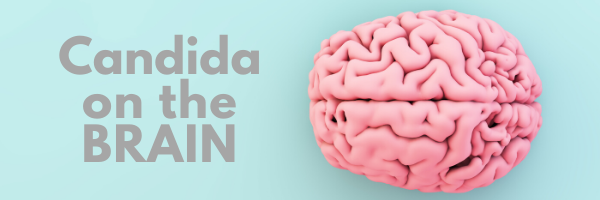
Candida is a form of yeast that lives throughout our bodies in small amounts: in our oral cavity, digestive tract, gut microbiome, and vaginal tract. When it is in a healthy balance with the good bacteria in the microbiome, it helps aid in healthy digestion and nutrient absorption. Problems can occur when there is too much Candida in relation to good bacteria. It can overpower the bacteria, leading to leaky gut, digestive issues, fungal infections, mood swings, poor memory, and brain fog.
Candida overgrowth can occur because of diet, antibiotics, and other medications, oral contraceptives, and stress. A diet high in refined carbohydrates, processed foods, sugar and alcohol feed the yeast and make it easy for the yeast to multiply and thrive. Antibiotics kill off the healthy bacteria causing an imbalance in the microbiome. Steroids and acid-blocker medications can also contribute to Candida overgrowth by causing hypochlorhydria, or reduced stomach acid. Hypochlorhydria reduces the immune system’s ability to kill off bacteria, parasites, viruses, mold, and yeast in food while it’s in the stomach, before it enters into the intestines, further contributing to an imbalanced microbiome.
Oral contraceptive use or menopausal hormonal imbalances can contribute to yeast overgrowth as yeast thrives in high synthetic estrogen conditions. Even pregnancy and delivery can contribute to imbalances in the microbiomes of children – such as if the mother took antibiotics when pregnant, had frequent yeast infections, or if the baby was delivered via C-section and bypassed the healthy vaginal flora during delivery.
When the body overproduces Candida, it can break down the wall of the intestines, causing leaky gut. Leaky gut causes a release of toxic byproducts into your body and disrupts your body’s ability to digest and absorb nutrients. When the gut-blood barrier is breached, the blood-brain barrier gets affected. Multiple research studies show that Candida crosses the blood-brain barrier invading the central nervous system.
The blood-brain barrier is a mechanism that protects the brain from pathogens that may exist in the blood. The barrier separates the brain’s tiny blood vessels, called capillaries, from the brain’s cells and tissue. When Candida crosses the blood-brain barrier, it triggers the activity of microglia, a neural-resident type of immune cell. These microglia become very active, “eating and digesting” the yeast.
Microglia produce a number of molecules that mediate an inflammatory response, leading to the capture of the yeast inside a granule-type of structure inside the brain called a “fungus-induced glial granuloma.” As these structures form, amyloid precursor proteins and molecules of a protein called amyloid-beta develop around the yeast cells. This creates similarities with Alzheimer’s diseases because these amyloid-beta and amyloid precursor proteins from the toxic brain plaques are what characterize this particular disease. These results prompt consideration that fungi could be involved with the development of chronic neurodegenerative disorders, such as Alzheimer’s, Parkinson’s, and multiple sclerosis.
Signs and symptoms of Candida overgrowth are:
- Brain fog, poor memory, ADHD, ADD, lack of focus, difficulty concentrating
- Irritability, mood swings, anxiety, depression: 90% serotonin is made in the gut.
- Chronic fatigue, fibromyalgia
- Digestive issues such as bloating, flatulence, constipation, SIBO/SIFO or diarrhea
- Skin issues including rashes, hives, eczema, psoriasis
- Vaginal infections, urinary tract infections, rectal itching, vaginal itching
- Severe seasonal allergies or itchy ears
- Strong sugar or refined carbohydrate cravings
The good news is that we have testing that helps to identify if Candida or yeast overgrowth might be affecting you and ways to treat this overgrowth with diet, nutrients, botanicals, and prescriptions. We may consider stool testing, blood antibody testing, and/or urine organic acids.
If you are experiencing any of the above symptoms, or have a known history of extensive antibiotic use, work with your functional medicine practitioner to help find out if you need to be assessed and treated.
For an in-depth look at the role Candida plays in many health challenges and what to do watch The Candida Summit.
References:
- https://www.ncbi.nlm.nih.gov/pmc/articles/PMC6159659/
- https://www.ncbi.nlm.nih.gov/pmc/articles/PMC3570177/
- https://www.ncbi.nlm.nih.gov/pmc/articles/PMC5976758/
- https://content.iospress.com/articles/journal-of-alzheimers-disease/jad150382
- Alonso, et al. “Fungal Infection in Patients with Alzheimer’s Disease.” Journal of Alzheimer’s Disease, IOS Press, 1 Jan. 2014, content.iospress.com/articles/journal-of-alzheimers-disease/jad132681. [PubMed]
- Jong, A Y, et al. “Traversal of Candida Albicans across Human Blood-Brain Barrier in Vitro.” Infection and Immunity, American Society for Microbiology, July 2001, www.ncbi.nlm.nih.gov/pmc/articles/PMC98530/.
- Zink, S, et al. “Migration of the Fungal Pathogen Candida Albicans across Endothelial Monolayers.” Infection and Immunity, U.S. National Library of Medicine, Dec. 1996, www.ncbi.nlm.nih.gov/pubmed/8945550. [PubMed]
- Broadwell R D, Baker-Cairns B J, Friden P M, Oliver C, Villegas J C. Transcytosis of protein through the mammalian cerebral epithelium and endothelium. III. Receptor-mediated transcytosis through the blood-brain barrier of blood-borne transferrin and antibody against the transferrin receptor. Exp Neurol. 1996;142:47–65. [PubMed] [Google Scholar]
- Fu Y, Rieg G, Fonzi W A, Belanger P H, Edwards J E J, Filler S G. Expression of the Candida albicans gene ALS1 in Saccharomyces cerevisiae induces adherence to endothelial and epithelial cells. Infect Immun. 1998;66:1783–1786. [PMC free article] [PubMed] [Google Scholar]
- Griffin F M J, Griffin J A, Leider J E, Silverstein S C. Studies on the mechanism of phagocytosis. I. Requirements for circumferential attachment of particle-bound ligands to specific receptors on the macrophage plasma membrane. J Exp Med. 1975;142:1263–1282. [PMC free article] [PubMed] [Google Scholar]
- Tuomanen E. Entry of pathogens into the central nervous system. FEMS Microbiol Rev. 1996;18:289–299. [PubMed] [Google Scholar]
- Zhang J R, Tuomanen E. Molecular and cellular mechanisms for microbial entry into the CNS. J Neurovirol. 1999;5:591–603. [PubMed] [Google Scholar]
- Zink S, Nass T, Rosen P, Ernst J F. Migration of the fungal pathogen Candida albicans across endothelial monolayers. Infect Immun. 1996;64:5085–5091. [PMC free article] [PubMed] [Google Scholar]

